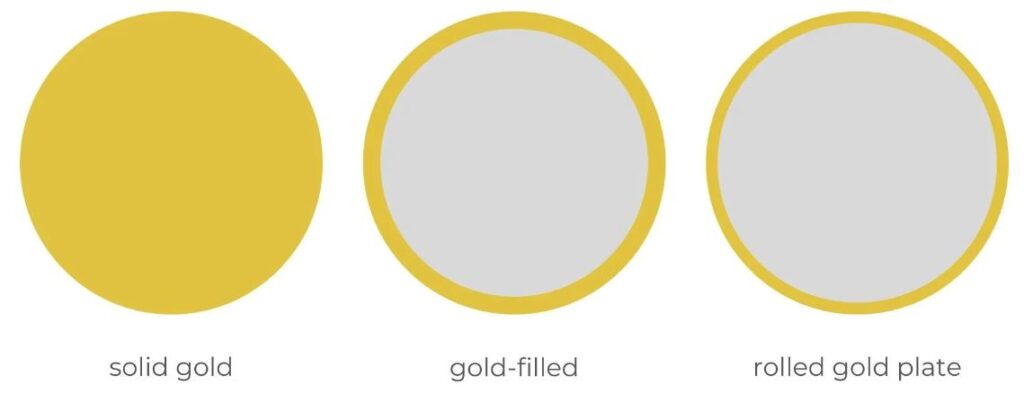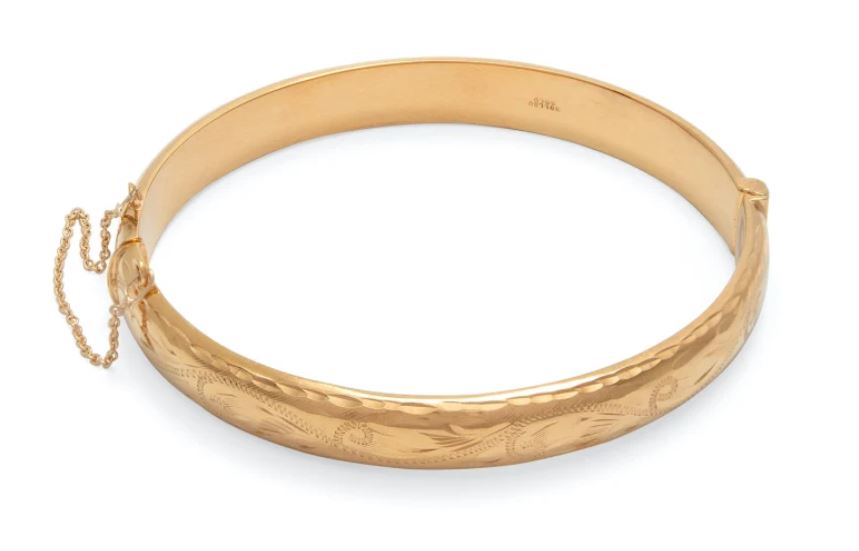What is Rolled Gold Meaning
Rolled gold is just another name for “gold filled” which means that a thick layer of gold is plated over a base metal i.e. copper or silver. This is the meaning of rolled gold. As per the American jewelry laws, weight of this gold layer should be at least 5 percent of the total weight of the jewelry. For example, you buy a 20 gram rolled gold chain. As per the laws, it should have at least 1 gram (5 percent of 20 grams) gold on top of it. If it is not, then it cant be called as rolled gold or gold filled legally.
In this article, we’ll explain what is rolled gold, rolled gold meaning, is rolled gold jewelry good and should you buy it.
Is Rolled Gold Real Gold?
Yes, definitely rolled gold is real gold. Only difference between rolled gold and traditional solid gold is that it is not all-solid gold. It is a thick layer of real gold rolled over a base metal like sterling silver. This is done due to bring down the overall cost of the jewelry item. It is important to note that rolled gold is not an alloy. It is just gold coated over sterling silver.
Rolled Gold vs Gold Filled
Rolled gold and gold filled are same. There is no difference.
Does Rolled Gold Tarnish
Rolled gold will not tarnish if it is coated with 14k gold or above. If it is coated with low purity gold like 9k or 10k, then it will tarnish. It is better to check with your jeweler first.
Comparison with Other Types of Gold
Here is a comparison of rolled gold with other gold types.
Solid Gold
Solid gold is made entirely of gold, with purity typically ranging from 10k to 24k. It is the most valuable and durable type of gold but also the most expensive.
Gold-Plated
Gold-plated items have a very thin layer of gold, often applied through electroplating. The thickness of the gold layer is less than 1 micrometer. They are the least expensive and least durable, as the gold layer can wear off relatively quickly.
Rolled Gold Plate
Rolled gold plated is more affordable variant of rolled gold. In this type, a thicker layer than gold plated is rolled over a base metal like sterling silver. However, thickness of rolled gold plated is less than normal rolled gold.
Gold Vermeil
Gold vermeil also contains a layer of gold plating but it is thicker than gold plating. Its thickness is about 2.5 micrometer. It is more durable than gold plating but far less than

Is Rolled Gold the Same as Gold Plated?
No, there is a difference of thickness of gold. Gold plated has a very thin gold layer of 1 micrometer or less. Rolled gold has a gold coating of about 25 to 30 micrometer thickness.
Why Use Rolled Gold?
Rolled gold offers a number of benefits.
1. Affordability
Due to increasing prices of solid gold jewelry, buyers often try to find affordable alternatives. That’s where rolled gold or gold filled jewelry comes in. It is affordable, shines like gold, is real gold. It allows customers to enjoy the look of gold without breaking the bank.
2. Durability and Longevity
Rolled gold is far more durable than gold plated or gold vermeil jewelry. It can be resistant to tarnishing as well. The thicker gold layer makes it more resistant to wear and tear compared to gold-plated items. With proper care, rolled gold jewelry can last for a long time without losing its luster.
It must be noted that rolled gold is never an alternative of solid gold jewelry in durability.
3. Gold-Alike Appearance
It has a solid gold alike appearance where no one can even tell whether a jewelry piece is a solid gold one or rolled gold one. As it has real gold on top layer, the color and shine of rolled gold make it a popular choice for jewelry, as it offers the look of gold at a more affordable price.
Only way to tell a rolled gold jewelry is by either jewelry stamp or gold testing.
4. Weight and Feel
It is lighter than solid gold but heavier than gold-plated items. This gives it a substantial feel without the high cost associated with solid gold.

Is Rolled Gold Jewelry Good
Rolled jewelry can be a good buy for someone who wants to get solid gold like jewelry at a lower cost. However, they don’t want to get gold plated or gold vermeil due to their less durability.
Rolled Gold Jewelry Stamp
Common jewelry stamps to spot rolled gold or gold filled jewelry are “RG” or “GF“. Apart, it can also contain numbers like “1/20“.
Here is a jewelry stamp of rolled gold made in 9K gold.

Will Rolled Gold turn Skin green?
No, rolled gold will not turn skin green if made in 14k or high purity gold. Addition of copper is the reason why gold can turn your skin green. This is due to increase the strength of the gold alloy. Lower purity gold like 10k contain more copper than gold, that’s why it is easily turn your skin green. However, higher purity gold i.e. 14k or 18k contain less percentage of copper which does not turn skin green.
It is better to first check with your jeweler about the manufacturing quality of rolled gold jewelry.
Will Rolled Gold Tarnish?
If rolled gold is made with 14k or higher purity gold, it will not easily tarnish. It is going to take at least 1 to 2 years before showing any significant signs of tarnishing. However, if top layer of gold is removed due to excessive scratching or falling incidents, it can tarnish quickly then.
FAQS about Rolled Gold
Here are some FAQ’s about rolled gold.
What is the difference between rolled gold and gold-plated jewelry?
The primary difference lies in the thickness of the gold layer. Rolled gold has a much thicker layer of gold, which makes it more durable and longer-lasting. In gold-plated jewelry, gold layer is extremely thin and applied through electroplating.
2. How long does rolled gold last?
With proper care, rolled gold jewelry can last for a long period of time like decades.
3. Is Rolled Gold Worth Anything?
Rolled gold is not worth much as it does not contain much gold.
Conclusion
Rolled gold represents a unique and valuable option in the world of jewelry, offering a perfect blend of affordability, durability, and aesthetic appeal. For centuries, it has provided an accessible way for individuals to enjoy the beauty of gold without the prohibitive costs associated with solid gold. By understanding what rolled gold is, how it’s made, and how it compares to other types of gold, consumers can make more informed decisions when purchasing jewelry.

